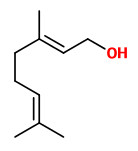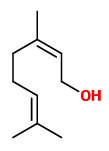Lathyrus odoratus L. - Fabaceae - sweet pea, Duftende Platterbse, Duftwicke, Gartenwicke
Annual climber, 50-200 cm tall, native to Italy (Sicily), cultivated worldwide; stem much branched, winged; leaflets 1-paired, ovate-oblong or elliptic; corolla red, purple, blue or white.
„Sweet peas have been cultivated since the 17th century and a vast number of cultivars are commercially available. They are grown for their flower colour (usually in pastel shades of blue, pink, purple and white, including bi-colours), and for their intense unique fragrance.“ wikipedia
The scent of sweet pea flowers may be characterised as 'rosy-floral' based on such compounds like citronellol, nerol, geraniol, citral, and rose oxide. Special notes are added by phenylacetaldehyde, phenylacetaldoxime, esters of phenylacetic acid, methyl anthranilate, and indol.
[The scent of orchids: olfactory and chemical investigations., Kaiser, R., Basel 1993, 42]
 (E)-ocimene (sweet herbal) |  (Z)-ocimene (warm herbal) |  linalool (citrus floral) |  geraniol (floral rosy) |  nerol (lemon floral) |  phenylacetaldehyde (green floral) |
Main volatile components of the floral fragrances from three sweet pea cultivars were (E)-β-ocimene (22.9-46.5%) with (Z)-β-ocimene (2.3-7.3%), linalool (16.6-23.6%), nerol (3.3-10.1%), geraniol (4.5-6.5%), phenylacetaldehyde (2.9-6.5%), and (E)-α-bergamotene (1.3-6.8%). Minor constituents were e.g. 3-methylbutanal, esters like methyl butanoate and methyl hexanoate, α-pinene, benzaldehyde, rose oxide, benzyl alcohol, methyl benzoate, citronellal, decanal, β-citronellol, citral, neryl acetate, geranyl acetate, β-caryophyllene, and benzyl 3-methylbutanoate.
[Porter, Alexander EA, et al. „Floral volatiles of the sweet pea Lathyrus odoratus.“ Phytochemistry 51.2 (1999): 211-214]
„The major components of the scent of cut sweet pea flowers (Lathyrus odoratus L. cv Royal Wedding) are (E) and (Z)-ocimene, linalool, nerol, geraniol and phenylacetaldehyde. The aroma is almost exclusively produced by the standard and wing petals, with very little emanating from the keel petals and other floral structures.“
Mean percentage contribution of the five major components of the aroma of fully opened sweet peas were (E)-ocimene 2.3%, (Z)-ocimene 41.5%, linalool 29.8%, nerol 10.5%, geraniol 8.5% and phenylacetaldehyde 6.4%.
[Aroma production from cut sweet pea flowers (Lathyrus odoratus): the role of ethylene. Sexton, R., Stopford, A. P., Moodie, W. T., & Porter, A. E., Physiologia Plantarum, Vol.124(3), 2005, 381-389]

Lathyrus odoratus L. var. hort., La Belgique horticole, journal des jardins et des vergers,
vol.21 p.167, t.11 (1871) plantgenera.org

Lathyrus odoratus, Saanich, Canada (2025) © Gabrielle Smith CC BY-SA 4.0 inaturalist.org
